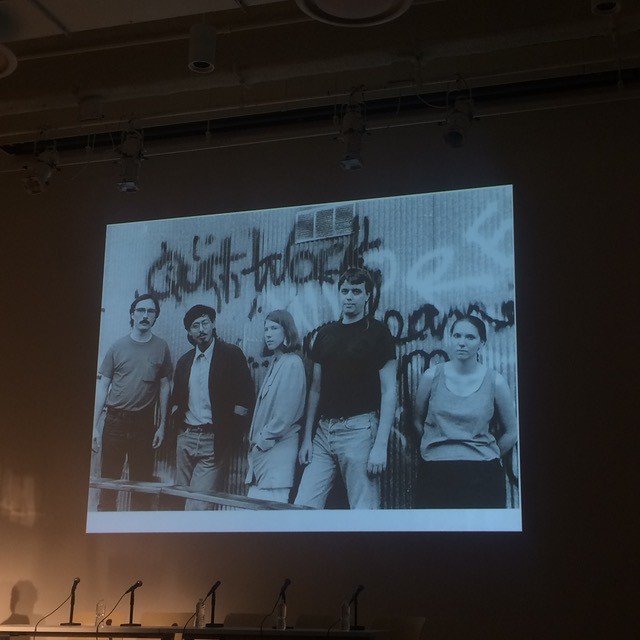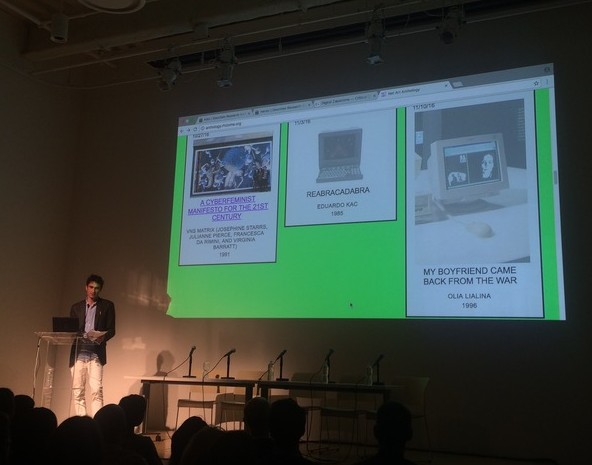This week’s contributing blogger, Melanie Bühler, is an independent curator working at the intersection of digital culture and contemporary art. She is responsible for the discussion series Lunch Bytes and the exhibition and research project Inflected Objects. A Fulbright recipient, she is presently pursuing an MA degree at NYU’s Institute of Fine Arts.
“As a net artist you don’t have the luxury to only be an artist, you also need to think about how to present and preserve your work, as the environment around it changes so fast.” – Olia Lialina
On Thursday, October 27, 2016, Rhizome held an event at the New Museum to launch and celebrate its newest online project, the Net Art Anthology, “a two-year online exhibition retelling the history of net art from the 1980s through the present day”. Over the course of a two year period, the digital arts organization will release one artwork per week on its website, restored and restaged and accompanied by an essay.
Rhizome’s director Zachary Kaplan was the first to address the audience, giving a brief overview of the anthology and its context. Next, the artistic director Michael Connor took the floor to explain the project in greater detail. Connor’s outline was followed by a short description of the anthology’s first three artworks by Rhizome’s assistant curator of net art Aria Dean. Then, it was Dragan Espenschied’s turn: the organization’s preservation director briefly discussed some of the conservation aspects of the project and Rhizome’s approach therein.

Rhizome’s Net Art Anthology Event at the New Museum, NY. Aria Dean, Dragan Espenschied, & Michael Connor. Courtesy of Rhizome.
Individual presentations by Ricardo Dominguez, artist and founder of Electronic Disturbance Theater, Martha Wilson, artist and founder of Franklin Furnace, Mark Tribe, artist and founder of Rhizome, and Olia Lialina, the net artist and researcher, followed, before they engaged in a panel discussion moderated by Michael Connor. The work of each of these artists is or will be featured in the anthology.
Kaplan began his introduction by situating the project as a conservation effort whose moment is marked by the organization’s 20th anniversary. He stressed the importance of conserving and exhibiting digital art on the Internet, in a moment in which, according to him, digital art is thriving, albeit mostly in an offline institutional setting. According to its director, Rhizome’s uniqueness then lies in its digital approach to digital art – the institution’s “space” to exhibit and showcase the art it holds, contextualizes and cares for being its website.

Rhizome’s Net Art Anthology Event at the New Museum, NY. Critical Art Ensemble. Courtesy of Rhizome.
Interestingly, and remarkable from a conservation point of view, Kaplan highlighted Rhizome’s importance as an organization by linking it specifically to its contribution to digital art’s conservation (which is just one of the institution’s facets, next to contextualizing and exhibiting digital art). Bringing together the institution’s different lines of work, The Net Art Anthology involves curatorial decisions, makes use of in house developed conservation tools (such as Oldweb.today and Webrecorder), and presents itself as a major editorial project.
To Connor, the Net Art Anthology is about storytelling. Accordingly, the artworks are not presented in a database structure but as individual re-stagings. The setting built for the “story” to unfold is a separate part of Rhizome’s website, or “microsite” as the organization calls it. Specifically designed for the project, it presents images, links, videos and text against backgrounds of bold colors (on the night of the event the website was brightly yellow, upon checking it later the backgrounds varied from ketchup red, bold green to saturated grey).
The first artworks that were featured on the website around the time of the event include VNS Matrix’s A Cyberfeminist Manifesto for the 21st Century (1991), Eduardo Kac’s Reabracadabra (1984) and Olia Lialina’s My Boyfriend Came Back From the War (1996). The presentation of these very different artworks is surrounded by text – they are not only accompanied with a commissioned essay but also with information on the artists and an extensive contextualization of the works.
In his introduction, Zachary Kaplan stated that Rhizome has no designated editorial, curatorial, or conservation departments and remains, despite its growth in recent years, hierarchically curious (which is somewhat contradictory to the fact that Rhizome’s team members were introduced with job titles indicating different departments). The event overall made clear how intrinsically connected digital art making is with the formats of its presentation and questions of preservation, a point that was made in various presentations. That these categories – content, format, preservation and context – are tightly interlinked was also illustrated in the way the event was put together: the presentations kept shifting between the description of individual artistic practices, preservation efforts and problems, formats to curate and show digital art, and the history of Rhizome as an institution.
The Net Art Anthology is an historic project for Rhizome and an important project in the history of presenting art online, unprecedented to my knowledge in its scope, aspiration and critical grounding. The clarity and thoughtfulness of this project, as outlined by Rhizome’s director and its team didn’t quite match the second part of the event: a panel discussion whose aim and focus remained vague.
VoCA is pleased to present this blog post in conjunction with the NYU/IFA Conservation Center’s Topics in Time-Based Media Art Conservation lecture series. The series is organized by Hannelore Roemich and Christine Frohnert and is generously supported by the Andrew W. Mellon Foundation. The full schedule can be found at https://www.nyu.edu/gsas/dept/fineart/events/time-based-media.htm

